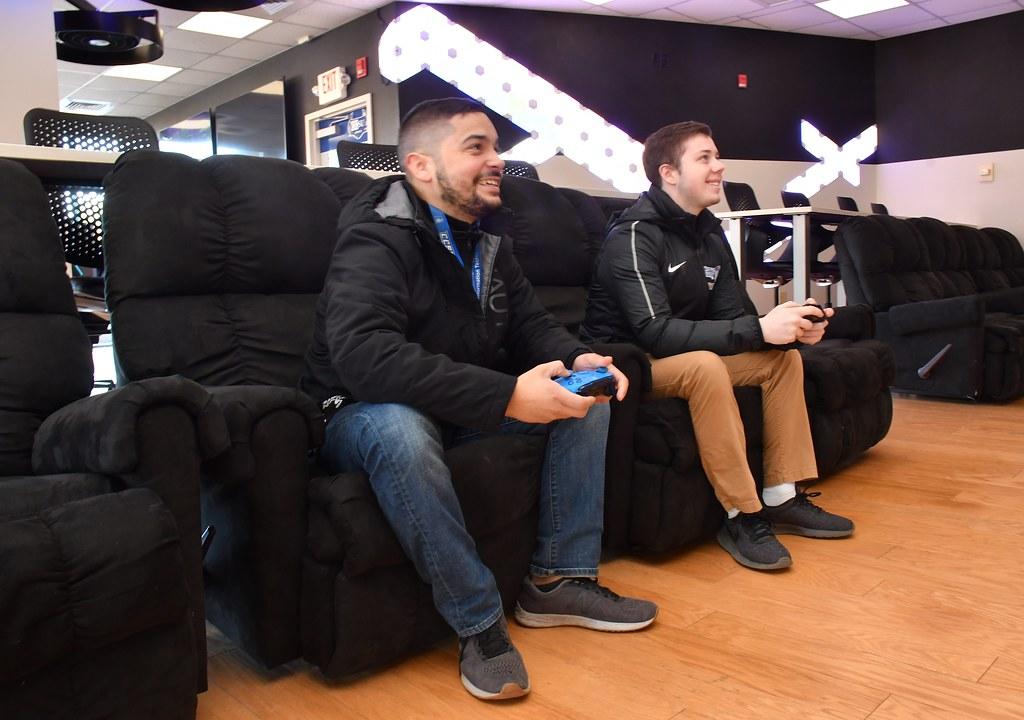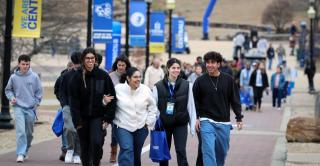
By Amy J. Barry
First impressions can be deceiving. When you look around the Central Esports Center, you will see students sitting at consoles in comfortable gaming chairs, controllers in hand, enthusiastically engaged in playing the latest video games. You may think this is an attractive, well-equipped space for students to congregate and have fun in their downtime between and after classes.
And you’d be correct.
But this is much more than a recreation room. It represents an exploding billion-dollar industry where research, academics, and gaming converge.
Earlier this year, President Zulma R. Toro recognized the multitude of opportunities the construction of such a center could provide.
“It will serve as the hub for research and development, in emerging fields such as interactive media design and game development,” Toro says. “It will also augment some of the University’s longer standing programs in business management, accounting, technology, cyber security, and computer science.”
When she approved the Esports Center, Toro placed Central at the forefront of a national movement at universities as the first dedicated academic and recreational Esports room to open on a Connecticut campus.
The center opened officially Sept. 6 in a former fitness center room on the north side of Memorial Hall. By 11:30 a.m., a line of students were waiting for the doors to open.
Build it and they will play
There are many reasons the Esports Center and its affiliated programs are a boon for the university.
There is, of course, built-in appeal for prospective students who grew up gaming. But Central’s Esports Center aims to reach out to and beyond the university’s circles of hard-core gamers.
“This is a true example of how we can be interdisciplinary at the university level because there is so much opportunity to use the room for recreational purposes, and now intercollegiate sports and the academic piece,” says Dr. Kimberly Kostelis, dean of the School of Education.
“Students are going to be more personally invested in their coursework and we’ll be keeping up with a generation of students we’re serving,” she adds.
According to George Claffey, Central’s chief information officer, once the decision was made to create the Esports Center, construction moved at breakneck speed. On June 4, all the exercise equipment in the former fitness room had been removed. Within 65 days the center was complete. With sponsorships and discounts, the final cost was about $300,000.
“Rarely do you see something like this being built in 65 days,” Claffey says. “I think this is demonstrating that we can build provocative, agile, innovative spaces that are real showcases here, and it’s not going to break the bank.”
Claffey led the team that chose the equipment for the Esports Center, often consulting with members of the university’s Esports Club to get input from students with expertise in video technology. They also reached out to established university partners.
“No one gave us equipment for free, but we talked to companies like Dell that had a 10-year relationship with the university,” Claffey says. “They came up with an exceptional discount using Alienware hardware, which is part of their gaming division.”
Central also received a grant from Unity 3D, a cross-platform game design engine — one of the top three tools internationally in video game construction. In total, Unity 3D awarded $100,000 worth of licenses used to develop, create, or design video game characters and worlds.
Microsoft also was actively involved, providing guidance, discounts on consoles, and local personnel to help meet the rapid construction timeline.
“Microsoft has had a presence at Central since the ‘90s, and one of the members of the Microsoft team was a Central alum,” Claffey says. “It’s great when current and past generations of the university community come together to help build something for the next generation of students.”
Let the games begin
A significant aspect of the Esports Center is competitive gaming, which Claffey notes is growing at an unparalleled rate, only surpassed by the Super Bowl in viewership.
Nicholas Streifel ’16, a technical support assistant at Central and faculty advisor to the Esports & Gaming Club, says the club is the university’s biggest, with more than 300 students currently registered.
He busts the myth that gaming is a boys club.
“The stereotype that gaming is just for guys came about because it’s been mostly an online thing and so you weren’t seeing women’s faces,” he says. “But as soon as you walk in the Esports Center there are a lot more women than you’d think, including about half our staff. And we want to be sure this room feels inclusive to everyone, women included.”
The Esports Center now serves as a dedicated practice and game space for club teams and newly formed intercollegiate teams that participate in the Eastern College Athletic Conference inter-collegiate Esports program, according to Streifel. The university is in the process of hiring a dedicated coach for ECAC competition and administration of the intercollegiate team will fall under the School of EducationEPS.
“We want to host regional competitions and get an intercollegiate circuit going, not unlike a varsity league with home games taking place in the Esports Center,” Streifel says. “We have a shoutcasting booth within the center, so when people are playing games we can record them and then live stream it out to whoever wants to watch it.
Cameras and microphones are set up in the shoutcasting room, so students interested in careers in radio and TV broadcasting will have the opportunity to gain more hands-on experience as commentators for live events.
Nicholas Pudlinski, a senior majoring in Psychology at Central, is president of the Esports & Gaming Club and a longtime video game hobbyist. He thinks gamification in academia is a smart move.
“Gaming is a monster industry, both on the development and competitive side, and the field continues to grow and diversify with new technology,” he says. “It is important that schools have programs that prepare students for such lucrative fields.”
Getting parents onboard
For parents who may question the value of a gaming facility at the university, Claffey points to his own child as an example.
He describes his 14-year-old son as an A-student and enthusiastic gamer, noting that he limits his gaming time at home. Although Claffey isn’t concerned his son will keep up his grades when he goes to college, he is concerned about the allure of unregulated, unsupervised gaming in his dorm room.
“I would much rather him come out in daylight and meet other people, who are passionate about what he’s passionate about — these games,” Claffey says. “A lot of those students are going to major in cybersecurity, management information systems, computer sciences, and the Esports Center is the kind of place where they’re going to be meeting each other.”
Pudlinski agrees and draws a distinction between students sitting alone and texting or messaging on their phones versus participating in the Esports Club and Esports Center.
“Since gaming is more interactive than social media, I think it produces more meaningful direct interactions among people,” he says. “When it comes to actual Esports, the interaction is bumped up to the extreme. Just like any other sports team, you have to communicate with your teammates to play effectively, and this can create meaningful connections and lasting bonds.”
Claffey argues that you’d be hard-pressed to find anyone at any age that isn’t playing something or isn’t hooked on something on his or her phone.
“All parts of our lives have been gamified,” he insists. “Whether you use Waze or GPS or a Fitbit. In today’s world, gaming and business are completely interrelated.”
That said, to ensure academic responsibilities don’t take a backseat to gaming, there is a student code of conduct for the Esports Center and time constraints are strictly enforced.
“An attendant is always present while the room is open,” Streifel says. “When students come in, they swipe their cards so we know they’re enrolled at the university and then they are given a two-hour time limit. We can see online the history of how long they’ve played that day and use discretion, for example, to give them another few hours later in the night. Surprisingly, we haven’t run into any scenarios where we’ve had any abuses of the time limits.”
What the future holds
The ways in which the university will integrate these new video technologies into curriculum and programs is a work in progress, according to Claffey and Kostelis.
“We do know that we’re going to have more classes that are in game design, digital storytelling, and character development,” Kostelis says.
She, too, says gamification is here to stay and the university needs to be responsive to it.
“More and more K-12 teachers are gamifying their curriculum, so this is how students are learning content. Then they’re coming here and teachers are using the traditional pedagogy,” she says. “So having the center here has gotten us to think outside of some of our traditional teaching methodologies.”
Kostelis says she has received many proposals from faculty that embrace the concept of Esports and the technology that it brings.
“We’re exploring having a minor or certificate for someone who, for example, is majoring in English and would like to work in the gaming industry,” she says. “We’ll be reviewing proposals from the Construction Management Department and how this can help them be more prepared. I think we’re going to see this being utilized in lots of different programs.”
University staff have proven equally invested in building up the program.
“People from Student Affairs and Academic Affairs and IT are all at the table together, which has not happened in other areas,” Kostelis says. “So I think this is a bigger deal that relates to the vision of Dr. Toro, as far as making sure we’re being collaborative and interdisciplinary in order to be stronger together.”

The Central Esports Center filled up quickly on its opening day in 2019. (Photo by John Atashian)

Photo by John Atashian



